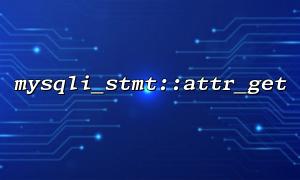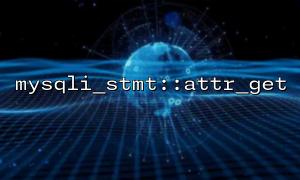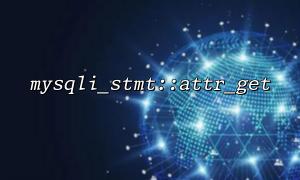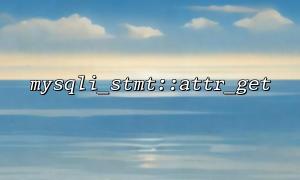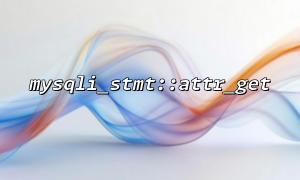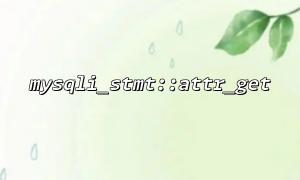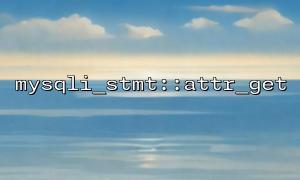PHP 개발에 Laravel을 사용하는 경우 프레임 워크는 기본적으로 데이터베이스 작업에 Eloquent ORM 및 PDO를 사용합니다. 그러나 일부 시나리오에서 호환성 또는 성능상의 이유로 개발자는 MySQLI 확장에서 제공하는 기능을 직접 사용하여 데이터베이스와 상호 작용할 수 있습니다. mysqli_stmt :: attr_get은 명령문 속성을 얻는 데 사용되는 mysqli_stmt 클래스의 메소드이며, 데이터베이스 연결 동작을 디버깅하거나 세분화 할 때 매우 유용합니다.
Laravel 프로젝트에서 mysqli_stmt :: attr_get을 보다 편리하게 사용하려면이를 캡슐화하고 데이터베이스 연결을 관리하고 논리를 균일하게 처리 할 수 있습니다. 다음은 특정 포장 체계 및 구현 단계입니다.
먼저 Laravel 프로젝트에서 MySQliservice 와 같은 기본 MySQLI 작업을 캡슐화하기 위해 서비스 클래스를 만들 수 있습니다.
앱/서비스 디렉토리에서 파일 mysqliservice.php 파일을 만듭니다.
<?php
namespace App\Services;
class MysqliService
{
protected $mysqli;
public function __construct()
{
$this->connect();
}
protected function connect()
{
$this->mysqli = new \mysqli(
env('DB_HOST', 'localhost'),
env('DB_USERNAME', 'root'),
env('DB_PASSWORD', ''),
env('DB_DATABASE', 'forge'),
env('DB_PORT', 3306)
);
if ($this->mysqli->connect_error) {
throw new \Exception('Connect Error (' . $this->mysqli->connect_errno . ') ' . $this->mysqli->connect_error);
}
}
public function prepare($query)
{
$stmt = $this->mysqli->prepare($query);
if (!$stmt) {
throw new \Exception('Prepare failed: ' . $this->mysqli->error);
}
return $stmt;
}
public function getStatementAttribute($stmt, int $attr)
{
if (!($stmt instanceof \mysqli_stmt)) {
throw new \InvalidArgumentException('Invalid statement object provided.');
}
return $stmt->attr_get($attr);
}
public function close()
{
if ($this->mysqli) {
$this->mysqli->close();
}
}
}
컨트롤러 또는 기타 클래스에서 mysqliservice를 사용하려면 AppServiceProvider 에서 서비스 바인딩을 수행 할 수 있습니다.
앱/제공 업체/appserviceprovider.php 편집 :
use App\Services\MysqliService;
public function register()
{
$this->app->singleton(MysqliService::class, function ($app) {
return new MysqliService();
});
}
이제 컨트롤러에서 직접 mysqliservice를 사용하고 getStatementAttribute 메소드를 호출하여 명령문 속성을 얻을 수 있습니다.
샘플 코드는 다음과 같습니다.
use App\Services\MysqliService;
class DatabaseController extends Controller
{
protected $mysqliService;
public function __construct(MysqliService $mysqliService)
{
$this->mysqliService = $mysqliService;
}
public function showAttribute()
{
$stmt = $this->mysqliService->prepare("SELECT * FROM users WHERE email = ?");
$stmt->bind_param("s", $email);
$email = "test@m66.net";
$stmt->execute();
// 우리가 얻고 싶다고 가정합니다 MYSQLI_STMT_ATTR_UPDATE_MAX_LENGTH 재산
$attrValue = $this->mysqliService->getStatementAttribute($stmt, MYSQLI_STMT_ATTR_UPDATE_MAX_LENGTH);
$stmt->close();
$this->mysqliService->close();
return response()->json(['attribute_value' => $attrValue]);
}
}
Att_get은 MySQLI_STMT 의 비교적 드물게 사용되는 방법이며 모든 PHP 환경이 기본적 으로이 확장 방법을 가능하게하는 것은 아닙니다. 배치 전에 가용성을 확인해야합니다.
Laravel에서 기본 MySQLI 작업을 사용하는 경우 서비스 계층으로 캡슐화하고 시스템의 견고성을 보장하기 위해 로깅 및 예외 처리를 고려하는 것이 좋습니다.
MySQLI는 일부 시나리오에서 낮은 수준의 제어 기능을 가지고 있지만 Laravel의 웅변 및 쿼리 빌더는 대부분의 경우 매일 개발에 더 적합한 높은 수준의 추상화를 제공합니다.
위의 캡슐화 방법을 통해 Laravel의 MySQLI_STMT :: ATTR_GET을 우아하게 호출하여 데이터베이스 연결 및 명령문 속성의 중앙 집중식 관리를 달성하여 코드를 더 명확하고 유지 관리 할 수 있습니다.



